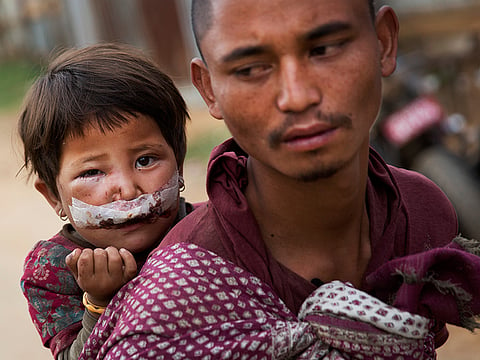Rescuers battle to reach survivors of new Nepal quake
Nepal officials tell people to leave quake-damaged buildings

KATHMANDU: Rescuers battled Wednesday to reach survivors of a deadly new earthquake in Nepal that triggered landslides and brought down buildings.
Thousands of traumatised survivors spent the night outdoors, afraid to return to their houses after Tuesday’s 7.3-magnitude quake hit, less than three weeks after the country was devastated by its deadliest quake in more than 80 years.
Dozens of people were killed in the latest disaster, bringing the overall death toll to more than 8,200 and compounding the already monumental challenge of reaching far-flung mountain communities in desperate need of shelter, food and clean water.
Laxmi Prasad Dhakal, spokesman for the Nepal home ministry, said 65 people had been confirmed dead so far in the new quake, which was centred 76 kilometres east of Kathmandu, and also killed 17 people in northern India.
“We had been focusing on relief distribution, but from yesterday our resources were deployed for rescue operations again,” he said.
Officials with bullhorns walked through the quake-damaged streets of this small Nepal town Wednesday, calling for people to leave buildings in danger of falling after a second major earthquake in less than three weeks.
“There is danger!” the officials called out over the bullhorns. “Leave the buildings!”
Most people, though, had fled into the open the day before, and had spent the night in tents or under plastic tarps.
Jamie McGoldrick, a UN official in Nepal, said the earthquake had aggravated problems in the areas hit by the earlier temblor.
“Damaged houses were further damaged or destroyed. Houses and schools building spared before were affected yesterday, roads were damaged,” he said Wednesday.
Among 14 quake-hit districts, some are very inaccessible. A large part of population could not be reached easily as roads have been damaged by the earthquake.
“Some are even difficult to reach by helicopter. We are facing monumental challenge here to support the government in these districts to have credible response,” he said.
Dolakha district’s chief administrator, Prem Lal Lamichane, said: “People are terrorised. Everyone is scared here. They spent the night out in the open.”
He asked the government to send more helicopters and supplies, and said there were many injured people stranded in villages.
Two large buildings damaged in the 7.8-magnitude quake that hit on April 25 collapsed in Kathmandu Tuesday.
But Dolakha and Sindhupalchowk, two of the districts worst affected by the original quake, bore the brunt of the damage caused by the fresh tremors.
The Red Cross said it had received reports of large-scale casualties in the town of Chautara in Sindhupalchowk, where its Norwegian branch is running a field hospital.
“Hundreds of people are pouring in. They are treating dozens for injuries and they have performed more than a dozen surgeries,” said spokeswoman Nichola Jones.
There were several reports of landslides in the worst-hit areas, making the task of getting relief to remote communities in the Himalayan country even more difficult.
Save the Children said the Gorkha region, near the epicentre of the April 25 quake, had also been hit by landslides and many key roads were blocked.
“Although our personnel are already present in quake-hit areas, these blockages will make it difficult to transport relief materials,” said police spokesman Kamal Singh Bam.
Many in Kathmandu had begun to return to their homes after weeks sleeping outdoors, but after Tuesday’s strong quake and tremors, large numbers once again spent the night under canvas.
“Yesterday’s quake shook us all, I couldn’t imagine sleeping in our house with the kids. But we haven’t been able to sleep in the tents either,” said Kabita Maharjan, a 38-year-old mother of two young children.
“It was shaking all night, how could we? My kids were terrified. Who knows what will happen now.”
The head of the country’s mountaineering association, Ang Tsering Sherpa, said many houses had collapsed and there were reports of damage to infrastructure in the eastern Khumbu region, where Mount Everest is located.
There were no immediate reports of casualties from there, although phone connections were poor and information has been slow to emerge.
The Nepalese government has acknowledged that it was overwhelmed by the scale of the April 25 disaster, which destroyed nearly 300,000 homes and left many more too dangerous to live in.
Scientists said Tuesday’s quake was part of a chain reaction set off by the larger one that struck on April 25 in Lamjung district west of Kathmandu.
“Large earthquakes are often followed by other quakes, sometimes as large as the initial one,” said Carmen Solana, a volcanologist at Britain’s University of Portsmouth.
“This is because the movement produced by the first quake adds extra stress on other faults and destabilises them,” she told the London-based Science Media Centre.
— Agencies
Sign up for the Daily Briefing
Get the latest news and updates straight to your inbox



